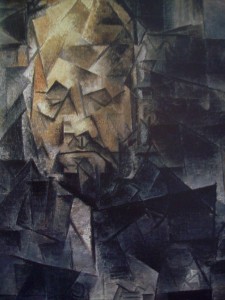
Pablo Picasso and Georges Braque bounced ideas off each other and enjoyed each others company. However, they knew they were working in new and adventurous territory when together they started the cubist movement.
Art critic Louis Vauxcelles described it when he noted how all the elements of paintings were reduced “to cubes.” Suddenly, Cubism became the name for the movement, and it swept all over the art world.
The painting to the left by Pablo Picasso is a portrait in the cubist style of art dealer Ambroise Vollard. It is a photograph of a photograph and does not portray the actual painting nor its value and is used in this blog for information and educational purposes only. The reason it was selected is because it represents a sample of what is known as Analytical Cubism.
Analytical Cubism: Natural forms broken down, or analyzed, and then rearranged, creating a new vision of the original subject.
In 1912, Synthetic Cubism – an art style showing images created in collage superseded the increasingly abstract Analytical Cubism.
The Cubists overturned the rules governing art and painting by their radical departure with artistic conventions by depicting the world in a completely new way. It may be said that the turned the world of art upon its head.
